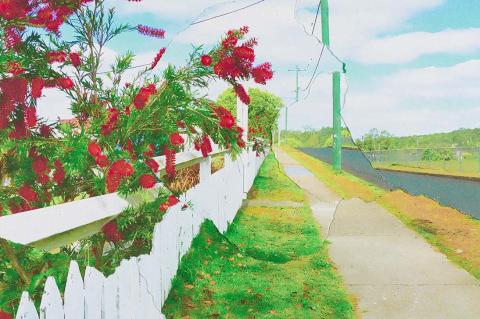Carol Jerrems: Photographs
By Michael Hawker
Artlines | 4-2020 | December 2020
QAGOMA acquired three important works by the celebrated Australian photographer Carol Jerrems, including Vale Street 1975, purchased with funds from Paul Taylor. As Michael Hawker writes, the three photographs capture Australia’s 1970s counterculture.
Australian artist Carol Jerrems’s work emerged from her strong commitment to feminism and her desire to represent the optimism and confidence that informed the broad social change of the era in which she was active. Tragically, her career spanned just nine years, from her first exhibition in 1971 to her death in February 1980, just three weeks before her 31st birthday. A quintessential image of the 1970s, Vale Street is a masterful balance of contemporary and classical references.
Rejecting the formality of the studio, Jerrems chose a backyard in the Melbourne suburb of St Kilda, towards the end of the day, to depict her friend Catriona Brown — then a 21-year-old aspiring actress — flanked by two of the artist’s sharpie students from Heidelberg Technical School, Mark Lean and Jon Bourke. ‘Sharpies’ were a subculture of predominately white, male, working-class adolescents, who adopted a distinctive hair style and dress code of knitted cardigans, tattoos and tight denim jeans. Despite the fact that the subjects had not met before the shoot, Jerrems elicits a sense of ease by placing them in close proximity and using only natural light. As she said of her working method:
I like things to be real and to be natural. I don't want to exploit people. I care about them; I'd like to help them if I could, through my photographs.1
Vale Street looks candid, but the contact sheet reveals her careful direction, having asked the three to remove their tops.2 In the photograph, Brown boldly steps forward, radiating self-assurance straight into the camera, unafraid of judgment. Her pendant is an ankh — the ancient Egyptian symbol of life, adopted by wearers to signify the new spirituality of the 1970s. In contrast, the two young men recede into a shadowy wall of greenery in the background, emanating a sublimated sense of menace. Brown, who was later interviewed on the ABC’s The Arts Show in 1999, commented that ‘[Jerrems] chose the boys being angry, cunning and watching, carefully guarding themselves against my openness, directness and honesty . . . She was a great observer of people’.3
Vale Street quickly became a defining image of its time and is today one of the most sought after and expensive Australian photographs. Its early success may be the reason why, a year later, Jerrems created Juliet holding ‘Vale Street’ 1976, taken in the garden of cinematographer Paul Cox, who was Jerrems’s teacher at Prahran Technical School. She remained close to Cox, acting in his films Skin Deep 1968 and The Journey 1972. Here, actress Juliet Bacskai, who was married to Cox, poses under a vine that mimics the composition of Vale Street. Both images are a reaction to the kind of photojournalism of the time, which exploited its subjects by taking pictures without their permission. Jerrems subverted this approach by working in a collaborative mode with her subjects, seeking their consent and sometimes intervening by consciously staging the photograph. Juliet holding ‘Vale Street’ is an example of such a staging: the subject holds the earlier photograph, forming a more complex and ambiguous reading of the women’s liberation movement that informs the original. Both works are indicative of Jerrems’s low-key, intimate approach and diaristic style of imagery.
Macquarie University: University Court, Yellow Cake Day Balloon 1977 comes from a folio commissioned by Macquarie University to document university life. It indicates a shift in her image-making: excited by the commission, Jerrems spent several weeks in May that year roaming the campus, producing a folio of six black-and-white images that responded to the following brief:
The photographs were to be taken within campus and there were no limitations on subject matter which might include any human activities or natural or built objects or scenes. They were to have the highest creative and technical quality and were to express a part of the spirit of the University.4
The resulting suite is fascinatingly austere. Instead of depicting the communality of campus life, Jerrems’s ‘vantage point is remote — she avoids the bustling busyness of university life’.5 Macquarie University: University Court, Yellow Cake Day Balloon records political activism on campus at an anti-uranium protest. Though small, blurred crowds appear in the background, this work maintains the solitary feel of the suite, inferred by the lone foreground figure, head bowed.
Jerrems has said of her practice:
I try to reveal something about people, because they are separate, so isolated; maybe it’s a way of bringing people together, by showing them photographs of each other, a sort of communication.6
She makes use of chance elements within her composition to extend the transmission of her ideas. In Macquarie University, for example, the upended balloon is suspended like a thought bubble above the protestor’s head. While the insight is quite literal, Jerrems’s greater mastery is evident in the way she suggests the deeper emotions of her subjects. A defining photographer of the 1970s — a time of significant cultural change — Carol Jerrems evocatively documented the rebellious, questioning spirit of her age.
Michael Hawker is Curator, Australian Art.
Endnotes
- See Gael Newton, Shades of Light: Photography and Australia 1839 to 1988, National Gallery of Australia, Canberra, 1988, p.142.
- Natalie King, Up Close: Carol Jerrems with Larry Clark, Nan Goldin and William Yang [exhibition catalogue], Heide Museum of Modern Art, Melbourne, 2010, p.47.
- King, p.47.
- King, p.53.
- King, p.53.
- King, p.55.
Connected objects

Vale Street 1975
- JERREMS, Carol - Creator
Related artists
JERREMS, Carol
1949
- 1980
Full profile
for JERREMS, Carol
Metadata, copyright and sharing information
About this story
- Subject
